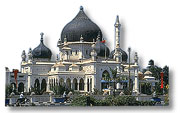Bujang
Valley (Lembah Bujang)
The Bujang Valley is a sprawling
historical site located in the foothills of Gunung Jerai. It is the richest
archaeological area in Malaysia. Archaeological research indicates that
an ancient Hindu-Buddhist kingdom ruled here as early as 300 AD. Relics
of the kingdom found at the site and now on display at the Archaeological
Museum include inscribed stone caskets and tablets, metal tools and ornaments,
ceramics, pottery, and Hindu icons. More than fifty ancient tomb temples,
called candi, have also been unearthed, many of which were built during
the Bujang Valley civilization's heyday. Near the most impressive and
well-preserved of these, in Pengkalan Bayang Merbok, is the Bujang Valley
Archaeological Museum. It is open from 9.30am-5pm daily.
Gunung
Jerai
Gunung Jerai (1,200 meters)
is the highest spot in the northern region of Peninsular Malaysia,
and as such it has for millennia served as a landmark for seafaring
traders. Myths and legends concerning this peak abound. One is of a
'king with fangs' who resided at the foothills of the mountain in the
Bujang Valley, now known to be the site of Kedah's ancient kingdom.
The peak of Gunung Jerai offers a breathtaking
vista, and can be reached via the nature trail or by road.
Balai
Nobat (Hall of Drums)
Balai Nobat belongs to the
old Sultanate of Kedah. The Hall features the nobat, the instruments
of the royal orchestra. It comprises drums, gongs and a traditional
flute. These instruments are played on special ceremonial occasions
only. The musical skills of the nobat are generally passed on from
father to son.
Pulau
Langkawi
Pulau Langkawi is an internationally
famous resort destination and an island of exceptional natural beauty.
Explore Langkawi in our Islands & Beaches pages.
Balai
Besar
Situated near Balai Nobat and
facing Masjid Zahir, Balai Besar is an impressive wooden pavilion, built
in 1898, which embodies certain aspects of Thai architecture. This 'great
hall' is used frequently for royal and state functions.
 Masjid
Zahir Masjid
Zahir
Officially opened in 1912,
this mosque is an architectural landmark. With black domes set off
against slender minarets, the Masjid Zahir is one of the most elegant
and aesthetically pleasing mosques in Malaysia. The state's Quran reading
competition is held annually within the premises of the mosque.
State
Museum
Although it is only about
fifty years old, the State Museum (Muzium Di Raja) is another fine
example of local architectural integration of Thai design characteristics.
It houses an interesting collection of objects and artifacts of Kedah's
royal and cultural heritage.
Pekan
Rabu
In translation Pekan Rabu
means "Wednesday Market," but the popularity of this vibrant
market has extended its business hours throughout the entire week,
from morning till midnight. Its colourful stalls sell handicrafts as
well as delicious food. Located near the
Government offices in Alor Setar.
Pantai
Merdeka
Located 60 km south of Alor
Setar, this 1 km beach is a popular day spot for bathing and makes
for a refreshing stop after a day of touring around the Bujang Valley
area. Pantai Merdeka also offers both diving and sport fishing off
its coast. A day trip fishing for mackerel and sailfish runs about
RM40 per person, as does a day of diving. Qualified diving guides are
available
|
